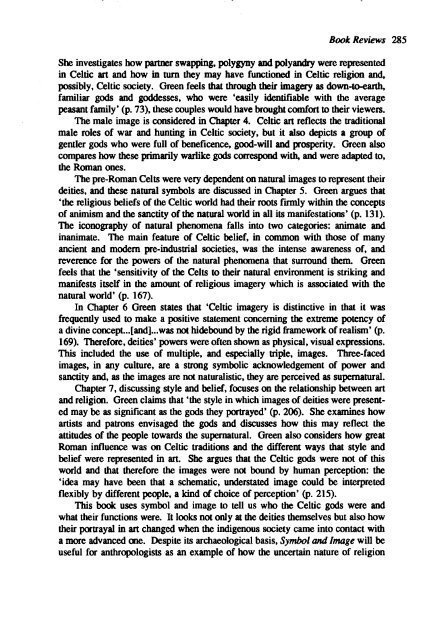1991 No. 1 CONTENTS - Institute of Social and Cultural ...
1991 No. 1 CONTENTS - Institute of Social and Cultural ...
1991 No. 1 CONTENTS - Institute of Social and Cultural ...
Create successful ePaper yourself
Turn your PDF publications into a flip-book with our unique Google optimized e-Paper software.
Book Reviews 285<br />
She investigates how partner swapping, polygyny <strong>and</strong> poly<strong>and</strong>ry were represented<br />
in Celtic art <strong>and</strong> how in turn they may have functioned in Celtic religion <strong>and</strong>,<br />
possibly, Celtic society. Green feels that through their imagery as down-to-earth,<br />
familiar gods <strong>and</strong> goddesses, who were 'easily identifiable with the average<br />
peasant family' (p. 73), these couples would have brought comfort to their viewers.<br />
The male image is considered in Chapter 4. Celtic art reflects the traditional<br />
male roles <strong>of</strong> war <strong>and</strong> hunting in Celtic society, but it also depicts a group <strong>of</strong><br />
gentler gods who were full <strong>of</strong> beneficence, good-will <strong>and</strong> prosperity. Green also<br />
compares how these primarily warlike gods correspond with, <strong>and</strong> were adapted to,<br />
the Roman ones.<br />
The pre-Roman Celts were very dependent on natural images to represent their<br />
deities, <strong>and</strong> these natural symbols are discussed in Chapter 5. Green argues that<br />
'the religious beliefs <strong>of</strong> the Celtic world bad their roots farmly within the concepts<br />
<strong>of</strong> animism <strong>and</strong> the sanctity <strong>of</strong> the natural world in all its manifestations' (p. 131).<br />
The iconography <strong>of</strong> natural phenomena falls into two categories: animate <strong>and</strong><br />
inanimate. The main feature <strong>of</strong> Celtic belief, in common with those <strong>of</strong> many<br />
ancient <strong>and</strong> modem pre-industrial societies, was the intense awareness <strong>of</strong>, <strong>and</strong><br />
reverence for the powers <strong>of</strong> the natural phenomena that surround them. Green<br />
feels that the 'sensitivity <strong>of</strong> the Celts to their natural environment is striking <strong>and</strong><br />
manifests itself in the amount <strong>of</strong> religious imagery which is associated with the<br />
natural world' (p. 167).<br />
In Chapter 6 Green states that 'Celtic imagery is distinctive in that it was<br />
frequently used to make a positive statement concerning the extreme potency <strong>of</strong><br />
a divine concepL .. [<strong>and</strong>] ... was not hidebound by the rigid framework <strong>of</strong> realism' (p.<br />
169). Therefore, deities' powers were <strong>of</strong>ten shown as physical, visual expressions.<br />
This included the use <strong>of</strong> multiple, <strong>and</strong> especially triple, images. Three-faced<br />
images, in any culture, are a strong symbolic acknowledgement <strong>of</strong> power <strong>and</strong><br />
sanctity <strong>and</strong>, as the images are not naturalistic, they are perceived as supernatural.<br />
Chapter 7, discussing style <strong>and</strong> belief, focuses on the relationship between art<br />
<strong>and</strong> religioo. Green claims that 'the style in which images <strong>of</strong> deities were presented<br />
may be as significant as the gods they portrayed' (p. 206). She examines how<br />
artists <strong>and</strong> patrons envisaged the gods <strong>and</strong> discusses how this may reflect the<br />
attitudes <strong>of</strong> the people towards the supernatural. Green also considers how great<br />
Roman influence was on Celtic traditions <strong>and</strong> the different ways that style <strong>and</strong><br />
belief were represented in art. She argues that the Celtic gods were not <strong>of</strong> this<br />
world <strong>and</strong> that therefore the images were not bound by human perception: the<br />
'idea may have been that a schematic, understated image could be interpreted<br />
flexibly by different people, a kind <strong>of</strong> choice <strong>of</strong> perception' (p. 215).<br />
This book uses symbol <strong>and</strong> image to tell us who the Celtic gods were <strong>and</strong><br />
what their functions were. It looks not only at the deities themselves but also how<br />
their portrayal in art changed when the indigenous society came into contact with<br />
a more advanced me. Despite its archaeological basis, Symbol <strong>and</strong> Image will be<br />
useful for anthropologists as an example <strong>of</strong> how the uncertain nature <strong>of</strong> religion
















